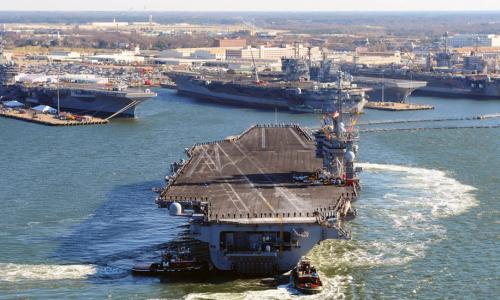Seas are projected to rise between 3.7 and 6.1 feet in the area around Camp Lejeune by the end of this century.
By 2100, the base's barrier islands—which provide storm surge protection for the mainland—and the low-lying areas along the New River could face daily flooding. Their inundation could affect storm surge exposure for the mainland portion of the camp.
Base information
This location is one of 18 military installations featured in the 2016 report, "The US Military on the Front Lines of Rising Seas."Camp Lejeune is located along the New River near Jacksonville, North Carolina. It includes several barrier islands, which provide a buffer between the Atlantic Ocean and the mainland.
The camp, which includes amphibious assault training facilities and live fire ranges, is supported by six additional facilities, including Marine Corps Air Station New River.
Camp Lejeune is an integral part of both the community and the economy of Onslow County. Including salaries, construction, services, and other expenditures, the annual economic contribution of the camp to the state and surrounding region is over $4 billion.
The results below outline potential future flooding scenarios for Camp Lejeune, assuming no new measures are taken to prevent or reduce flooding.
Projected exposure to coastal flooding
The camp's exposure to coastal flooding is projected for the years 2050, 2070, and 2100 based on the National Climate Assessment’s midrange or “intermediate-high” sea level rise scenario (referred to here as “intermediate”) and a “highest” scenario based on a more rapid rate of increase.
Tidal flooding, land loss, and storm surge from hurricanes were all modeled. In this analysis, land inundated by at least one high tide each day is considered a loss. This is a conservative metric: in reality, far less frequent flooding would likely lead to land being considered unusable.
Preparing for rising seas
The gap between the military’s current preparedness for sea level rise and the threats outlined here is large and growing.
In order to plan effectively for the long term, military decision makers with authority over Camp Lejeune need to understand how sea level rise may permanently alter the landscape of this coastal installation and where the threat of storm surge may become intolerable.
To take action, however, individual installations like Camp Lejeune will need more detailed analysis and resources to implement solutions.
Congress and the Department of Defense should, for example, support the development and distribution of high-resolution hurricane and coastal flooding models; adequately fund data monitoring systems such as our nation’s tide gauge network; allocate human, financial, and data resources to detailed mapping and planning efforts at military installations; and, as adaptive measures are identified, allocate resources for these projects, many of which will stretch over decades.
Our defense leadership has a special responsibility to protect the sites that hundreds of thousands of Americans depend on for their livelihoods and millions depend on for national security.
Additional maps and resources
This analysis modeled exposure to coastal flooding for four different points in time (2012, 2050, 2070, and 2100) and two different sea level rise scenarios.
For each time horizon and scenario, we analyzed storm surge from Category 1 through 5 hurricanes, the extent and frequency of flooding from extra-high tides, and inundation from ordinary high tides.
For more, please see the methodology used for this analysis.




